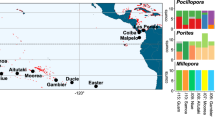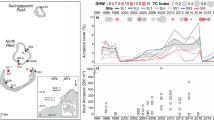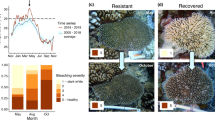Abstract
Climate change and other anthropogenic stressors have severe impacts on the ecological functioning of marine ecosystems by causing widespread declines in population sizes and, for surviving individuals, limiting the capacity for population recovery through sexual reproduction. Ecological theory suggests that affected populations can suffer local extinction because of Allee effects, where reduced population densities prevent gamete encounters, resulting in reproductive failure. Without understanding the relationship between the density or spacing of spawning individuals and fertilization success, coral reefs may unknowingly pass a critical population threshold, further complicating conservation efforts. In this study we conducted a series of independent manipulative field experiments using three common simultaneous hermaphroditic spawning Acropora species in two locations (One Tree Island, Great Barrier Reef, and Ngermid Bay, Palau) to assess evidence of Allee effects in small populations. Experimental ‘patches’ of corals were structured with mean intercolonial distances ranging from 1 m to 2 m, resulting in low but measurable fertilization success (1.2–8.7%). We developed a mechanistic coral fertilization model and validated its predictions against this empirical data, finding close alignment. Depending on the species and their colony size, the model predicts that adult coral densities need to exceed 13–50 colonies per 100 m2 for reefs to ensure 10% fertilization success.
This is a preview of subscription content, access via your institution
Access options
Access Nature and 54 other Nature Portfolio journals
Get Nature+, our best-value online-access subscription
$32.99 / 30 days
cancel any time
Subscribe to this journal
Receive 12 digital issues and online access to articles
$119.00 per year
only $9.92 per issue
Buy this article
- Purchase on SpringerLink
- Instant access to full article PDF
Prices may be subject to local taxes which are calculated during checkout



Similar content being viewed by others
Data availability
The datasets generated and analysed during this study are deposited in the CSIRO Data Access Portal at https://doi.org/10.25919/v4ce-de91 (ref. 62). Source data are provided with this paper.
Code availability
The code used to implement the model described in this study is available via GitHub at https://github.com/gerard-ricardo/fert-model.
References
Courchamp, F., Clutton-Brock, T. & Grenfell, B. Inverse density dependence and the Allee effect. Trends Ecol. Evol. 14, 405–410 (1999).
Hoegh-Guldberg, O. et al. Coral reefs under rapid climate change and ocean acidification. Science 318, 1737–1742 (2007).
Richards, Z. T., Juszkiewicz, D. J. & Hoggett, A. Spatio-temporal persistence of scleractinian coral species at Lizard Island, Great Barrier Reef. Coral Reefs 40, 1369–1378 (2021).
Frieler, K. et al. Limiting global warming to 2 °C is unlikely to save most coral reefs. Nat. Clim. Change 3, 165–170 (2013).
Allee, W. Animal Aggregations: A Study in General Sociology (Chicago Univ. Press, 1931).
Nozawa, Y., Isomura, N. & Fukami, H. Influence of sperm dilution and gamete contact time on the fertilization rate of scleractinian corals. Coral Reefs 34, 1199–1206 (2015).
dela Cruz, D. W. & Harrison, P. L. Optimising conditions for in vitro fertilization success of Acropora tenuis, A. millepora and Favites colemani corals in northwestern Philippines. J. Exp. Mar. Biol. Ecol. 524, 151286 (2020).
Buccheri, E., Ricardo, G. F., Babcock, R. C., Mumby, P. J. & Doropoulos, C. Fertilisation kinetics among common Indo-Pacific broadcast spawning corals with distinct and shared functional traits. Coral Reefs 42, 1351–1363 (2023).
Levitan, D. R. Influence of body size and population density on fertilization success and reproductive output in a free-spawning invertebrate. Biol. Bull. 181, 261–268 (1991).
Hughes, T. P. et al. Global warming impairs stock–recruitment dynamics of corals. Nature 568, 387–390 (2019).
Harrison, P. L. et al. Mass spawning in tropical reef corals. Science 223, 1186–1189 (1984).
Oliver, J. & Babcock, R. Aspects of the fertilization ecology of broadcast spawning corals: sperm dilution effects and in situ measurements of fertilization. Biol. Bull. 183, 409–417 (1992).
Omori, M., Fukami, H., Kobinata, H. & Hatta, M. Significant drop of fertilization of Acropora corals in 1999: an after-effect of heavy coral bleaching? Limnol. Oceanogr. 46, 704–706 (2001).
Levitan, D. R. et al. Mechanisms of reproductive isolation among sympatric broadcast spawning corals of the Montastraea annularis species complex. Evolution 58, 308–323 (2004).
Babcock, R. C. et al. Synchronous spawnings of 105 scleractinian coral species on the Great Barrier Reef. Mar. Biol. 90, 379–394 (1986).
Baird, A. H., Guest, J. R. & Willis, B. L. Systematic and biogeographical patterns in the reproductive biology of scleractinian corals. Annu. Rev. Ecol. Evol. Syst. 40, 551–571 (2009).
Ricardo, G. F., Jones, R. J., Clode, P. L., Humanes, A. & Negri, A. P. Suspended sediments limit coral sperm availability. Sci. Rep. 5, 18084 (2015).
Styan, C. A. Polyspermy, egg size, and the fertilization kinetics of free-spawning marine invertebrates. Am. Nat. 152, 290–297 (1998).
Ricardo, G. F., Jones, R. J., Negri, A. P. & Stocker, R. That sinking feeling: suspended sediments can prevent the ascent of coral egg bundles. Sci. Rep. 6, 21567 (2016).
Rogers, J. G., Pláganyi, É. E. & Babcock, R. C. Aggregation, Allee effects and critical thresholds for the management of the crown-of-thorns starfish Acanthaster planci. Mar. Ecol. Prog. Ser. 578, 99–114 (2017).
Denny, M. W. & Shibata, M. F. Consequences of surf-zone turbulence for settlement and external fertilization. Am. Nat. 134, 859–889 (1989).
Babcock, R., Mundy, C. & Whitehead, D. Sperm diffusion models and in situ confirmation of long-distance fertilization in the free-spawning asteroid Acanthaster planci. Biol. Bull. 186, 17–28 (1994).
Lehtonen, J. & Dardare, L. Mathematical models of fertilization—an eco-evolutionary perspective. Q. Rev. Biol. 94, 177–208 (2019).
Hughes, T. P. et al. Global warming and recurrent mass bleaching of corals. Nature 543, 373–377 (2017).
Dietzel, A., Bode, M., Connolly, S. R. & Hughes, T. P. The population sizes and global extinction risk of reef-building coral species at biogeographic scales. Nat. Ecol. Evol. 5, 663–669 (2021).
Levitan, D. R., Sewell, M. A. & Chia, F.-S. How distribution and abundance influence fertilization success in the sea urchin Strongylocentotus franciscanus. Ecology 73, 248–254 (1992).
Knowlton, N. The future of coral reefs. Proc. Natl Acad. Sci. USA 98, 5419–5425 (2001).
Nordborg, F. M., Brinkman, D. L., Ricardo, G. F., Agustí, S. & Negri, A. P. Comparative sensitivity of the early life stages of a coral to heavy fuel oil and UV radiation. Sci. Total Environ. 781, 146676 (2021).
Albright, R. & Mason, B. Projected near-future levels of temperature and pCO2 reduce coral fertilization success. PLoS ONE 8, e56468 (2013).
Lam, E. K. Y. et al. High levels of inorganic nutrients affect fertilization kinetics, early development and settlement of the scleractinian coral Platygyra acuta. Coral Reefs 34, 837–848 (2015).
Coma, R. & Lasker, H. R. Effects of spatial distribution and reproductive biology on in situ fertilization rates of a broadcast-spawning invertebrate. Biol. Bull. 193, 20–29 (1997).
Iguchi, A., Morita, M., Nakajima, Y., Nishikawa, A. & Miller, D. In vitro fertilization efficiency in coral Acropora digitifera. Zygote 17, 225–227 (2009).
Wolstenholme, J. K. Temporal reproductive isolation and gametic compatibility are evolutionary mechanisms in the Acropora humilis species group (Cnidaria; Scleractinia). Mar. Biol. 144, 567–582 (2004).
Panero, M., Galbraith, G. F., Srinivasan, M. & Jones, G. P. Roles of depth, current speed, and benthic cover in shaping gorgonian assemblages at the Palm Islands (Great Barrier Reef). Coral Reefs 42, 1045–1057 (2023).
Wolanski, E. & Hamner, W. M. Topographically controlled fronts in the ocean and their biological influence. Science 241, 177–181 (1988).
Mumby, P. J. et al. Allee effects limit coral fertilization success. Proc. Natl Acad. Sci. USA 121, e2418314121 (2024).
Velázquez, E., Martínez, I., Getzin, S., Moloney, K. A. & Wiegand, T. An evaluation of the state of spatial point pattern analysis in ecology. Ecography 39, 1042–1055 (2016).
Ludington, C. A. Tidal modifications and associated circulation in a platform reef lagoon. Aust. J. Mar. Freshwater Res. 30, 425–430 (1979).
Golbuu, Y., Gouezo, M., Kurihara, H., Rehm, L. & Wolanski, E. Long-term isolation and local adaptation in Palau’s Nikko Bay help corals thrive in acidic waters. Coral Reefs 35, 909–918 (2016).
Kurihara, H. et al. Potential local adaptation of corals at acidified and warmed Nikko Bay, Palau. Sci. Rep. 11, 11192 (2021).
Sheppard, C., Harris, A. & Sheppard, A. Archipelago-wide coral recovery patterns since 1998 in the Chagos Archipelago, central Indian Ocean. Mar. Ecol. Prog. Ser. 362, 109–117 (2008).
Osborne, K., Dolman, A. M., Burgess, S. C. & Johns, K. A. Disturbance and the dynamics of coral cover on the Great Barrier Reef (1995–2009). PLoS ONE 6, e17516 (2011).
Marshall, D. J. & Bolton, T. F. Sperm release strategies in marine broadcast spawners: the costs of releasing sperm quickly. J. Exp. Biol. 210, 3720–3727 (2007).
Baird, A. H. et al. An Indo-Pacific coral spawning database. Sci. Data 8, 35 (2021).
Howlett, L. et al. Population and clonal structure of Acropora cf. hyacinthus to inform coral restoration practices on the Great Barrier Reef. Coral Reefs 43, 1023–1035 (2024).
Shaver, E. C. et al. A roadmap to integrating resilience into the practice of coral reef restoration. Glob. Change Biol. 28, 4751–4764 (2022).
Nolan, M. K. B., Schmidt-Roach, S., Davis, A. R., Aranda, M. & Howells, E. J. Widespread bleaching in the One Tree Island lagoon (Southern Great Barrier Reef) during record-breaking temperatures in 2020. Environ. Monit. Assess. 193, 590 (2021).
Barneche, D. R. et al. dataaimsr: an R client for the Australian Institute of Marine Science Data Platform API which provides easy access to AIMS Data Platform. J. Open Source Softw. 6, 3282 (2021).
Ricardo, G. F. et al. Sediment characteristics influence the fertilisation success of the corals Acropora tenuis and Acropora millepora. Mar. Pollut. Bull. 135, 941–953 (2018).
Zuchowicz, N. et al. Assessing coral sperm motility. Sci. Rep. 11, 61 (2021).
Harrison, X. A. A comparison of observation-level random effect and beta-binomial models for modelling overdispersion in binomial data in ecology & evolution. PeerJ 3, e1114 (2015).
Magnusson, A. et al. glmmTMB: Generalized linear mixed models using template model builder. R package version 0.1 (2017).
Kahle, D. J. & Wickham, H. ggmap: spatial visualization with ggplot2. R J. 5, 144–161 (2013).
Teo, A. & Todd, P. A. Simulating the effects of colony density and intercolonial distance on fertilisation success in broadcast spawning scleractinian corals. Coral Reefs 37, 891–900 (2018).
Vogel, H., Czihak, G., Chang, P. & Wolf, W. Fertilization kinetics of sea urchin eggs. Math. Biosci. 58, 189–216 (1982).
Benedini, M. & Tsakiris, G. Water Quality Modelling for Rivers and Streams (Springer, 2013).
Lentz, S. J., Davis, K. A., Churchill, J. H. & DeCarlo, T. M. Coral reef drag coefficients—water depth dependence. J. Phys. Oceanogr. 47, 1061–1075 (2017).
Von Kármán, T. Mechanical Similitude and Turbulence (National Advisory Committee for Aeronautics, 1931).
Baird, M. E. & Atkinson, M. J. Measurement and prediction of mass transfer to experimental coral reef communities. Limnol. Oceanogr. 42, 1685–1693 (1997).
Styan, C. A. & Butler, A. J. Fitting fertilisation kinetics models for free-spawning marine invertebrates. Mar. Biol. 137, 943–951 (2000).
Rothschild, L. & Swann, M. The fertilization reaction in the sea-urchin egg: a propagated response to sperm attachment. J. Exp. Biol. 26, 164–176 (1949).
Ricardo, G., Doropoulos, C., Mumby, P. & Babcock, R. Great Barrier Reef and Palau manipulative-field coral fertilisation experiments. CSIRO https://doi.org/10.25919/v4ce-de91 (2025).
Acknowledgements
We thank the Traditional Owners of the Great Barrier Reef, particularly the Byelle, Gooreng Gooreng, Gurang and Taribelang Bunda First Nations people of the Port Curtis Coral Coast, and the Manbarra First Nations people of the Palm Islands, for permission to work in their Sea Country with free prior and informed consent. We thank their Elders, past, present and emerging, and acknowledge their continuing spiritual connection to their Sea Country. Work on the Great Barrier Reef was conducted under Great Barrier Reef Marine Park Authority permit nos. G21/44774.1 and G22/46963.1, and work in Palau under Marine Research Permit RE-22-11. We thank S. Blanchfield, J. Goldman, M. Tonks and staff from One Tree Island Research Station, Heron Island Research Station, Orpheus Island Research Station, the National Sea Simulator at AIMS, and the Palau International Coral Research Center for assistance during the field work. J. Crosswell, T. Malthus and S. Noonan kindly provided equipment. We thank A. Wuppukondur and D. Callaghan for their advice on the hydrodynamic modelling options and A. Teo and P. Todd for providing the source code for their model. We acknowledge the facilities and technical assistance of the Centre for Microscopy and Microanalysis, University of Queensland. This work was supported by the EcoRRAP subprogram (https://gbrrestoration.org/program/ecorrap/), which is part of the Reef Restoration and Adaptation Program (RRAP) (https://gbrrestoration.org/). RRAP is funded by the partnership between the Australian Government’s Reef Trust and the Great Barrier Reef Foundation. The funders had no role in study design, data collection and analysis, decision to publish or preparation of the manuscript.
Author information
Authors and Affiliations
Contributions
Conceptualization: C.D., P.J.M. and G.R. Formal analysis: G.R. and P.J.M. Funding acquisition: C.D. and P.J.M. Investigation: G.R., P.J.M., R.C.B. and A.K. Methodology: G.R., P.J.M., C.D., R.C.B. and E.B. Visualization: G.R. Supervision: P.J.M. and C.D. Writing—original draft preparation: G.R. Writing—review and editing: all authors.
Corresponding author
Ethics declarations
Competing interests
The authors declare no competing interests.
Peer review
Peer review information
Nature Ecology & Evolution thanks Joana Figueiredo and the other, anonymous, reviewer(s) for their contribution to the peer review of this work.
Additional information
Publisher’s note Springer Nature remains neutral with regard to jurisdictional claims in published maps and institutional affiliations.
Extended data
Extended Data Fig. 1 Biological imagery and model parameterisation experiments.
(a) Scanning electron microscopy of coral egg-sperm bundles, eggs, and sperm. Parameterisation of each gamete stage and process influences the predictions from the fertilisation model. The relative sizes of gametes have been adjusted for clarity. (b) The effects of egg concentration on coral fertilisation success at two sperm concentrations, analysed with a binomial GLMM. The test was two-sided, and p-values were adjusted for multiple comparisons using the Holm-Bonferroni method. Darker points and line represent 106 sperm mL−1 (n = 18 biological replicates), and lighter points and line represent 104 sperm mL−1 (n = 19 biological replicates). Lines show the estimated mean, and shaded bands represent the 95% confidence intervals. (c) Egg ascent rates of Acropora cf. tenuis (n = 11 biological replicates) compared to bundle ascent rates of Acropora cf. tenuis (n = 13 biological replicates) previously reported in Ricardo, et al.60. (d) Fertilisation success of Acropora cf. tenuis following time from spawning (min) with a 5-min sperm contact exposure time, analysed with a binomial GLMM. The test was two-sided, and p-values were adjusted for multiple comparisons using the Holm-Bonferroni method. Darker points and line represent 7×107 sperm mL−1 (n = 24 biological replicates), and lighter points and line represent 2×106 sperm mL−1 (n = 21 biological replicates). Lines show the estimated mean, and shaded bands represent the 95% confidence intervals. Note the log scale on the x-axis.
Extended Data Fig. 2 Validation and releases of tracer dyes to simulate coral sperm dispersion.
(a) Vertical decay of coral sperm and tracer dyes over time within a single water column. Curves represent concentration profiles for sperm (n = 20 time measurements), rhodamine WT (n = 9), and fluorescein (n = 9). Inset: Absorbance spectral profiles of coral sperm at four sperm concentrations (sperm mL−1), rhodamine WT dye at multiple concentrations, and fluorescein dye at multiple concentrations. (b) (Left) A representative example of a fluorescein dye release from a research vessel imaged with a UAV. (Right) The same image after the colour band indexing. (c) Current velocity (n = 11762) measured 1 m above the benthos along a north-facing reef slope at Wistari Reef during a ~ 4 mo. deployment. Measurements represent a time series recorded by a single tilt meter. Dotted lines represent the median and 2.5th and 97.5th percentiles. Inset: Density plot of the current velocities. Thicker bar denotes ~1 SD from the median, thinner bar denotes ~2 SDs from the median.
Extended Data Fig. 3 Intercolonial distances of A. hyacinthus adult colonies on the reef slope and crest at Uchelbeluu Reef.
Intercolonial distances of A. hyacinthus adult colonies on the reef slope (n = 1 transect) and crest (n = 3 transects) at Uchelbeluu Reef in Palau. Dashed lines indicate the median distances for each habitat.
Extended Data Fig. 4 Simulated relationships between mean intercolonial distances of adult colonies and species-specific coral cover or colony density.
Simulated relationships between mean intercolonial distances of adult colonies and (a) species-specific coral cover or (b) colony density. Dashed lines denote mean intercolonial distances of 1 m.
Supplementary information
Supplementary Information
Supplementary Methods 1, Discussion 1, Tables 1–4 and References.
Source data
Source Data Fig. 1 and Extended Data Figs. 1–3
Spatial distribution of Acropora sperm concentration and field fertilization success data.
Rights and permissions
Springer Nature or its licensor (e.g. a society or other partner) holds exclusive rights to this article under a publishing agreement with the author(s) or other rightsholder(s); author self-archiving of the accepted manuscript version of this article is solely governed by the terms of such publishing agreement and applicable law.
About this article
Cite this article
Ricardo, G., Doropoulos, C., Babcock, R.C. et al. Critical thresholds of adult patch density and spacing during coral fertilization. Nat Ecol Evol (2025). https://doi.org/10.1038/s41559-025-02844-y
Received:
Accepted:
Published:
DOI: https://doi.org/10.1038/s41559-025-02844-y



